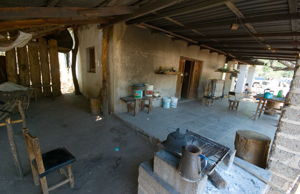Reserve Management
Determining the immediate, short-term, and long-term needs at the Northern Jaguar Reserve is the first step in transforming this land from a working cattle ranch into a true wildlife sanctuary. We are currently evaluating the existing infrastructure, operations and maintenance issues, how to best incorporate weather stations and other instruments to establish baseline studies, questions of ecotourism and visitation, and priority restoration projects. This process will help us decide where to focus our efforts in the early stages of reserve management as well as for the long haul.
Some of our long-term objectives:
 Inventory all species of plants and animals found on the reserve,
Inventory all species of plants and animals found on the reserve,- Promote jaguar prey species through recovery of food sources,
- Establish a water quality monitoring program for the Río Aros,
- Map and photograph all natural water sources on the reserve (seeps, springs, creek beds) as well as artificial water sources (wells, storage tanks, excavated ponds),
- Upgrade, clean, deepen, and amplify water sources to benefit wildlife, including piping to otherwise dry areas,
- Perform annual maintenance of improved water sources,
- Identify locations of invasive plant species with a particular focus on buffelgrass,
- Employ specialists in invasive plant eradication for multi-year removal projects in specific locations,
- Compile and map locations of erosion, land degradation, and depauperate vegetation,
- Construct gabions, rock cortines, and other small control structures to prevent erosion, slow stream flow, minimize water loss, and maximize moisture retention in creek beds,
- Recover and restore vulnerable habitat for migrating birds,
- Renovate and repair ranch houses at La Ventana and Babisal in an ecologically sensitive manner to create a scientific research station and future visitor center,
- Partner with ranchers and other groups to create a regional jaguar monitoring program,
- Expand the reserve’s restoration practices beyond its boundaries through training, education, and capacity building amongst neighbors, and
- Custom design an ecotourism component for the area that educates tourists and earns additional income.

